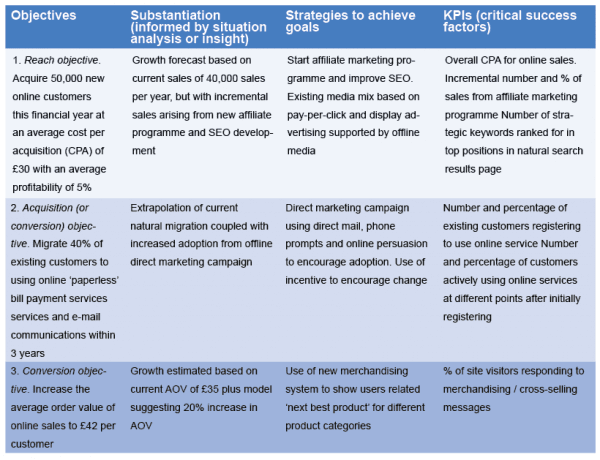An example of how to structure a digital marketing strategy plus examples from other sectors
We launched Smart Insights in 2010, to help marketers develop digital marketing strategies, since we saw that many businesses faced the challenge of where to start when creating a digital marketing strategy. The most popular downloads were templates for structuring a digital marketing strategy. We quickly found from member feedback that examples were important, and we now have examples of digital marketing strategies in many sectors, which we cover at the end of this post.
Although digital marketing platforms and technology has changed immensely in this time, particularly with the recent growth in use of Generative AI, the fundamentals of creating a digital strategy are the same. Some of the AI recommendations on digital marketing strategy and many of the human ones fail to get these essentials right, they go straight to recommending different digital marketing channels like organic and paid search and social media and email marketing. They miss the fundamentals we’ll cover in this example, i.e. starting with the customer, aligning the strategy with the business goals and using a data-driven approach.
Why use RACE for structuring digital marketing strategies?
We created the RACE (Reach, Act, Convert, Engage) framework since it helps give a simple, but sufficiently detailed approach for structuring digital marketing strategies. It offers a comprehensive, action-oriented, and customer-centric approach. By covering the entire customer lifecycle, RACE ensures that every stage, from awareness to loyalty, is effectively addressed. This framework integrates performance evaluation through key performance indicators, allowing for data-driven decisions and continuous optimization. Combining the RACE framework with the Opportunity > Strategy > Action (OSA) process provides a robust structure for both strategic planning and tactical execution. You can read more in about how to use RACE to structure a plan in our post Introducing The RACE Growth System and RACE Planning Framework: practical tools to improve your digital marketing.
Structure for an example digital marketing strategy
Let’s drill-into these fundamentals in more detail, what are the essentials of a digital marketing strategy to ensure comprehensive planning and effective execution. Here are the key components that should be included:
1 Detailed situation analysis including
- Marketplace Analysis: Understanding the market conditions, customer needs, and competitive landscape – particularly for online customer journeys
- SWOT Analysis: Identifying strengths, weaknesses, opportunities, and threats – we recommend the TOWs approach
- Internal capability and performance review. To start and audit we recommend our digital marketing benchmarking templates and Digital marketing strategy audit/health check.
2 Clear SMART objectives
Digital channels are the most measurable ever, so we need to put in place not only broad goals, but SMART Objectives, that’s Specific, Measurable, Achievable, Relevant, and Time-bound objectives that align with the overall business goals.
A key technique for setting objectives is to ensure that your objectives marketplace analysis and strategy are well defined. We use this technique in our templates across RACE to link these three. This works well as a one page summary of your strategy were a big fan of these efficient summaries!
I recommend this grid layout from our digital marketing plan workbook for aligning your strategies with your objectives, since it provides a simple one to two-page summary of your marketing strategy. Much more effective than a long report your colleagues or clients won’t read…
3 Segmentation, Targeting and Positioning
This is a fundamental of marketing and digital marketing strategy, but it will often be missed if you’re focused on digital channels. Our resources explain how digital channels can help support:
- Customer Segmentation: Defining and targeting different customer segments based on demographics, behaviour, and needs.
- Persona Development: Creating detailed customer personas to tailor marketing efforts.
- Brand Positioning: Establishing the brand’s position in the market and how it differs from competitors. Value Proposition: Clearly communicating the unique value the brand offers to its customers.
4 Digital acquisition strategy
This is the core tactical part of your plan, you should prioritize initiatives from these areas:
- Digital Traffic Generation: Techniques to drive traffic to your website or other digital assets including search, display ads, email and social media as featured on this table.
- Offline channel integration:
- Lead Generation: Methods to capture leads and grow the customer base.
Conversion Strategy: - User Experience (UX): Optimizing the website and landing pages for better user experience and higher conversion rates.
- Conversion Rate Optimization (CRO): Techniques to improve the rate at which visitors convert to leads or customers.
- Content strategy and calendar Aligns with customer needs, business goals and how to deploy them. It should also include engagement tactics: Strategies to engage customers through various channels like social media, email marketing, and community building.
5 Digital retention strategy
This includes:
Customer Loyalty: Strategies to retain customers and increase their lifetime value.
Engagement and Advocacy: Encouraging repeat business and turning customers into brand advocates.
Technology and Data Strategy: Marketing Technology: Tools and platforms used for marketing automation, data analytics, CRM, etc. Data Management: Collecting, analyzing, and leveraging data to make informed marketing decisions.
6 Budget and Resource Allocation
Of course, it’s essential your plan includes a budget.
- Budget Planning: Allocating budget across various digital marketing activities.
- Resource Management: Ensuring the right team and tools are in place to execute the strategy.
Measurement and Analytics:
7. KPIs, Metrics and performance improvement:
- Digital marketing dashboard: Defining key performance indicators to measure the success of digital marketing efforts.
- Agile Planning: Regularly reviewing and updating the strategy based on performance data and market changes.
- Experimentation: Running experiments and A/B tests to optimize different aspects of the digital marketing strategy.
The digital marketing strategy example
So these are the main requirements for an effective digital marketing strategy. You can see that there is a lot to consider, so it’s really important to have an efficient way of summarizing the strategy, using the Objectives > Strategy > KPIs table above.
I’ve selected the example below for a B2B laser eye treatment or surgery company since it’s an example of a high value complex product so it is also similar to a B2C strategy example.
Opportunity section — Where are we now, what do we want to achieve?
This section covers the marketplace analysis review of internal performance and objective setting.
| Step | Category | Performance/Impact |
|---|---|---|
| Step 1: Performance Review | Year-on-year sales | -8% |
| Year-on-year profitability | -6% | |
| Year-on-year website leads | -12% | |
| Impact on leads by Google algorithm changes | -18% | |
| Retention | N/A within our laser eye treatment market | |
| Step 2: Marketplace Review | Search intent affected by Generative AI | Fewer impressions in Google and lower CTR due to more SERP features |
| Average position for target keywords | Declined, reducing organic site visits | |
| Paid traffic acquisition costs | Increased by 10% | |
| Importance of comparison sites | Less important than previously, advertising opportunity | |
| Step 3: PESTLE Review | Economic | Decline in affordability of our services caused by ‘cost-of-living crisis’ |
| Technological | Generative AI now used by more competitors and consumers familiar | |
| Legal | No longer possible to buy third-party lists for online targeting | |
| Step 4: Key Issues SWOT | Declining search intent (impressions) and clicks for our target keywords | Paid search acquisition costs have increased |
| Social media ads potential | Greater potential due to targeting approach | |
| Step 5: SMART Objectives | Sales forecast based on conversion funnels | Increase digital leads by 5% YoY |
| Digital ad investment | Fixed at same as previous year |
Strategy section — How will we prioritize investment to achieve our goals?
This section covers the marketing fundamental and prioritization of the strategic initiatives for digital marketing.
| Step | Category | Details |
|---|---|---|
| Step 1: Brand Value Proposition | Local Brand Positioning | Updated local brand positioning featuring local expertise |
| Digital Value Proposition | Improve digital value proposition featuring on reviews and ratings | |
| Tone-of-Voice | Update tone-of-voice to make service less technical and more reassuring | |
| Step 2: Customer Segmentation and Targeting | Target Audience | Three core 25-40 y.o. target audience personas unchanged |
| Personalized Content | Improve on-site personalized content recommendations for returning visitors | |
| Browse-based Targeting | Personalized browse-based targeting for outbound messaging | |
| Step 3: Modern Marketing Mix | Place | Opening two new treatment centres |
| Physical Evidence | New aftercare guarantee | |
| Pricing | Interest-free payments to be introduced | |
| Step 4: RACE Communications Strategy | Reach | Test shifting proportion of budget from Google Ads to Social Ads |
| Act | Content personalization | |
| Convert | Updated prospect email sequence featuring aftercare guarantee and interest-free payments | |
| Step 5: Business Model Canvas Summary | Value Proposition | Aftercare guarantee and interest-free payments |
| Channels | Social media ads increased |
Action section — How will we implement and resource our plan?
This includes budgeting, measurement and implementation using 90-day planning. It also includes improvements to process.
| Step | Category | Details |
|---|---|---|
| Step 1: Marketing Budget and Resource Plan | Acquisition | See digital channel budget |
| Other expenditure | See Marketing budget | |
| Step 2: Marketing Dashboard | KPIs | Define KPIs for reviewing performance across the customer lifecycle |
| Updates | Updates to Google Lookers Studio monthly YoY dashboard using RACE | |
| Step 3: Campaign Plan Process | Campaign Goals | Adopt new campaign-process template |
| AI Policy | Define and launch Marketing AI policy and training | |
| Step 4: Always-on Plan and MarTech | Automation | Implement RACE 90-day planning to achieve test-learn-refine approach to always-on |
| Quarterly Targets | Set quarterly targets for always-on priority focus activities | |
| Step 5: 90-day Action Plan Summary | Q1 Priority Activities | Reach: Home page AB tests to boost conversion |
| Act | Introduce FAQ content to increase conversion | |
| Convert | Improved email nurture sequence | |
| Engage | Improve email and mobile push notifications for customer onboarding |
These tables are a simplified vesion of our Free marketing plan template Word document download.
Industry sector examples of digital marketing plans
Since every market sector has unique characteristics, we have also created a series of in-depth digital marketing strategy examples for premium members. These are also Word documents, but with more detail than the free template.
We also have some top-level examples for other sectors in this article: Three digital marketing plan examples.



